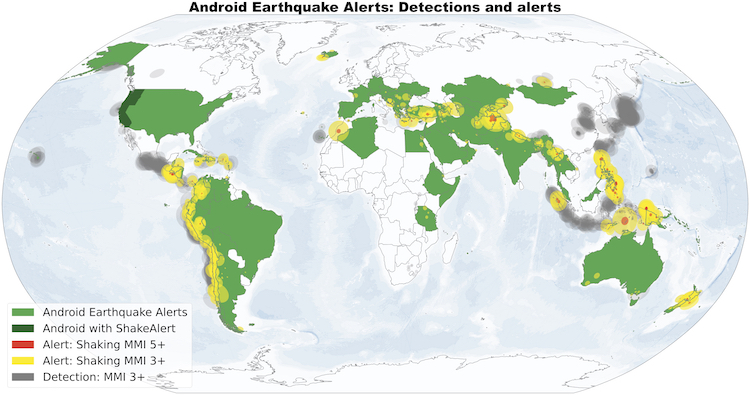Science
Android Phones Transform Earthquake Detection and Alerts Globally

The global network of Android smartphones has evolved into an effective early warning system for earthquakes, providing users with crucial seconds to react before shaking begins. This innovative use of technology stems from a three-year study conducted by researchers at Google, which involved millions of devices across 98 countries. The findings highlight the potential for the Android Earthquake Alert (AEA) system to save lives, particularly in regions lacking established earthquake warning infrastructures.
According to Richard Allen, a co-leader of the study and director of the Berkeley Seismological Laboratory at the University of California, Berkeley, “By using Android smartphones, which make up 70% of smartphones worldwide, the AEA system can help provide life-saving warnings in many places around the globe.” Traditional earthquake warning systems, typically reliant on specialized seismic sensors, have been implemented in countries such as Mexico and Japan. These systems detect earthquakes near the epicenter and send warnings to affected areas. Even a few seconds of advance notice can enable individuals to take protective actions, such as the widely recommended “drop, cover, and hold on” method.
Establishing conventional seismic networks is costly, and many earthquake-prone areas lack such systems. However, smartphones are ubiquitous and equipped with built-in accelerometers. As their usage surged in the 2010s, scientists began investigating how these devices could assist in earthquake detection. Allen stated, “Although the accelerometers in these phones are less sensitive than the permanent instruments used in traditional seismic networks, they can still detect tremors during strong earthquakes.”
Leveraging Smartphone Technology for Earthquake Alerts
By the late 2010s, various teams had developed smartphone applications capable of sensing earthquakes, including Mexico’s SkyAlert and Berkeley’s ShakeAlert. The recent study advances this concept significantly. “By using the accelerometers in a network of smartphones like a seismic array, we are now able to provide warnings in some parts of the world where they didn’t exist before and are most needed,” said Allen.
Working alongside Marc Stogaitis, a principal software engineer at Android, Allen and his research team tested the AEA system from 2021 to 2024. During this period, the app detected an average of 312 earthquakes each month, with magnitudes ranging from 1.9 to 7.8. For earthquakes measuring 4.5 or higher, the system dispatched “TakeAction” alerts designed to prompt immediate protective actions. On average, the system issued these alerts 60 times per month, reaching approximately 18 million individual notifications.
In addition to the urgent alerts, the system also provided “BeAware” notifications for areas expected to experience a shaking intensity of 3 or 4. To evaluate the alerts’ effectiveness, the researchers collected user feedback through Google Search surveys from February 5, 2023, to April 30, 2024. A total of 1,555,006 individuals responded, indicating that 85% experienced shaking, with 36% receiving alerts before the ground began to move.
How the AEA System Operates
The AEA system operates on the same principles of seismic wave propagation as traditional systems. When an Android smartphone is stationary, the accelerometer detects sudden increases in acceleration triggered by P and S waves during an earthquake. Once a pattern is recognized, the smartphone transmits acceleration data and an approximate location to Google servers, which analyze the information to identify potential seismic sources.
“When a candidate earthquake source satisfies the observed data with a high enough confidence, an earthquake is declared, and its magnitude, hypocenter, and origin time are estimated based on the arrival time and amplitude of the P and S waves,” explains Stogaitis. This capability is integrated into the core system software of Google Play Services, meaning it is activated by default on most Android devices. Given the billions of Android smartphones in circulation, this system offers earthquake detection capabilities globally, spanning both affluent and developing nations.
Looking ahead, Allen and his team aspire to leverage the same technology to develop additional hazard-reducing tools. For instance, they envision creating ground shaking maps that could enhance emergency response efforts following earthquakes.
Currently, the researchers are focused on refining the AEA system, utilizing real-time data from global earthquakes to improve the quality of detections and the effectiveness of alerts. “We think that we can continue to enhance both the quality of earthquake detections and our strategies for delivering effective alerts,” Allen concluded. The comprehensive findings of this study have been published in the journal Science, underscoring the significance of this technological advancement in earthquake preparedness and response.
-

 World2 days ago
World2 days agoCoronation Street’s Shocking Murder Twist Reveals Family Secrets
-

 Entertainment4 months ago
Entertainment4 months agoKate Garraway Sells £2 Million Home Amid Financial Struggles
-

 Entertainment3 months ago
Entertainment3 months agoAnn Ming Reflects on ITV’s ‘I Fought the Law’ Drama
-

 Health3 months ago
Health3 months agoKatie Price Faces New Health Concerns After Cancer Symptoms Resurface
-

 Entertainment3 weeks ago
Entertainment3 weeks agoCoronation Street Fans React as Todd Faces Heartbreaking Choice
-

 World3 weeks ago
World3 weeks agoBailey Announces Heartbreaking Split from Rebecca After Reunion
-

 Entertainment5 days ago
Entertainment5 days agoTwo Stars Evicted from I’m A Celebrity Just Days Before Finale
-

 World5 days ago
World5 days agoKevin Sinfield Exceeds Fundraising Goal Ahead of Final Marathons
-

 Entertainment3 months ago
Entertainment3 months agoCoronation Street’s Carl Webster Faces Trouble with New Affairs
-

 Entertainment3 months ago
Entertainment3 months agoWhere is Tinder Swindler Simon Leviev? Latest Updates Revealed
-

 Entertainment4 months ago
Entertainment4 months agoMarkiplier Addresses AI Controversy During Livestream Response
-

 Science2 months ago
Science2 months agoBrian Cox Addresses Claims of Alien Probe in 3I/ATLAS Discovery





















